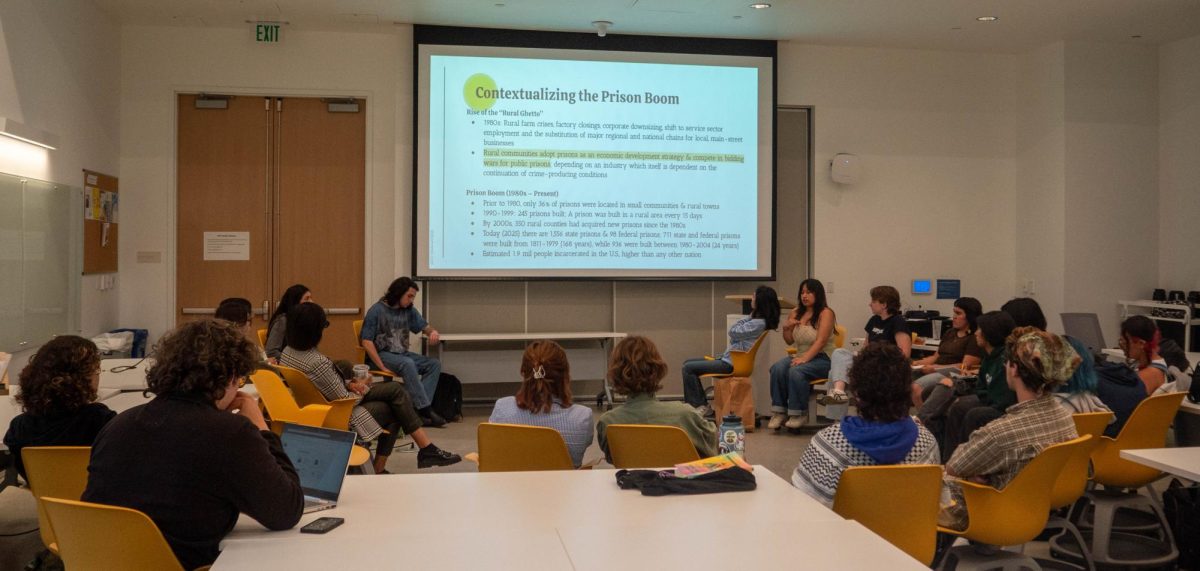
Charn Hong
By Fall Quarter 2024, a group of students in UC San Diego’s urban studies and planning department had become disillusioned with the department and its “carefully-censored curriculum.” After witnessing the University’s response to the Gaza Solidarity Encampment and labor strikes, the group banded together to form the Radical Planning Collective, a student organization dedicated to promoting radical innovation and perspectives in the field of USP. RPC’s work culminated in USP’s first entirely student-led class: this Spring Quarter’s USP 198: Directed Group Study.
USP 198 is focused on reenvisioning state planning, which the group says upholds capitalism and the neoliberal model. Traditional USP narratives in education reinforce this model, in part because dissenting participants’ voices are not equally heard. To counter this at the university level, RPC developed this student-run class.
The structure of the course was inspired by a student-led class from 2021 in the ethnic studies department — ETHN 198: Abolition Medicine. However, while only a few students served as teachers for ETHN 198, USP 198 takes a collective approach — all enrolled students are responsible for teaching one another through group discussions and research presentations. Rain Lins, a fourth-year USP major who spearheaded the launch of the class, explained the rationale behind this non-hierarchical structure.
“We don’t want to just have our group of six or seven of us talking about this class,” Lins said. “We wanted to create what we saw was lacking in the [USP] department. They have a lot of clubs and organizations, but none are focused on giving you alternative perspectives in planning.”
Lins and their fellow RPC members took inspiration for the course from USP alumna Allison Gable’s honors thesis: “A Student’s Guide to Radical Planning Praxis.” In September 2024, RPC reached out to Gable’s thesis faculty advisor, USP professor Kelema Lee Moses, to ask her to be the staff advisor for the course, proposing it as a continuation of Gable’s thesis.
After Moses signed on, RPC began collectively developing the syllabus within the organization. As the group wanted as many students as possible to participate in this process, it discussed teaching and learning pedagogies in its public org meetings. Moses took on a hands-off facilitator role to encourage the students to embrace the non-hierarchical structure.
“We were pretty public about … this class, and anyone could come to our meetings and join the process of planning it,” third-year USP major Joyce Pang said. “There are people that are facilitating the class, but we’re also enrolled.”
Now, the class has begun, and these students are hard at work. During regular USP 198 class sessions, students separate into small groups and present on a topic of their choice. Outside of class, students work on a long-term urban planning project that addresses non-campus issues.
To give students an informed perspective, RPC also sought to build connections with local initiatives that align with its goals. It invited guest speakers to the class throughout the quarter to do teach-ins. For instance, members from Tierras Indígenas, a nonprofit dedicated to encouraging human connection to land and returning it to its original inhabitants, gave a teach-in to the class on April 9.
“It [was] good because we were doing a teach-in on radical housing solutions outside of the neoliberal frameworks,” Pang explained. “They came in and talked about how they were founded, their funding, and what their governance looks like.” Tierras Indígenas’ teach-in gave a real-world example of how students can look outside colonial frameworks to work toward more unified, compassionate living communities.
According to third-year USP major Jaden Tsai, many RPC members hope that underclassmen in USP 198 will retake the class in future years to pass down the knowledge and educational frameworks this year’s cohort of students have developed.
Tsai explained that the class is not limited to only USP students. This quarter, underclassmen both inside and outside of the USP department were drawn to the class.
Kavya Suresh, a first-year student double majoring in ethnic studies and critical gender studies, enrolled in the class upon several friends’ recommendations and after seeing RPC’s flyers around campus.
“I’m interested in exploring the intersection between anti-racist and sustainable planning,” Suresh said. “Also, I’m very passionate about disability justice and accessibility.”
Suresh joined the course to aid her exploration of these interests, as well as to learn how to identify and dissect inaccessible architecture as a non-USP student. As the class winds down, she has big visions for the course’s impact on the University in the future.
“I’m hoping that we can collaborate with student organizations and generate their support,” Suresh said. She also wants to “invite university administrators and speak to them about what we see at this campus, what we envision for it, and what possibilities are available for us.”
At the very least, the course has already affected members of the USP department.
“Myself and my colleagues, we think about this department as one where we embrace reciprocity,” Moses said. “We teach our students, but our students teach us as well. [I will be] able to take back the issues that they are concerned with to my colleagues and to have a conversation about the ways in which we teach our own classes. Hopefully it can foster generative dialogue with the rest of the department.”
Moses especially admires students’ efforts to collectively develop and facilitate the class.
“I’m very proud of the students and what they’ve accomplished [and] the ways in which they’ve built community with each other, as we think about ways to reimagine not only what a university education is, but what it is that we do in the field of urban studies and planning,” Moses said.